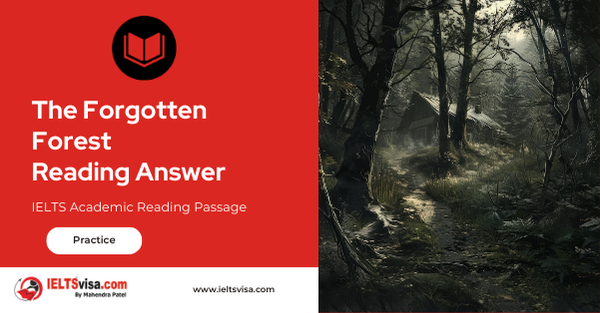The Forgotten Forest Reading Answer
IELTS Academic Reading Passage
Paragraph A
The beauty and the biodiverity of the longleaf pine forest are well-kept secrets, even in its native South. Yet it is among the richest ecosystems in North America, rivalling tallgrass prairies and the ancient forests of the Pacific Northwest in the number of species it shelters. And like those two other disappearing wildlife habitats, longleaf is also critically endangered.
Paragraph B
In longleaf pine forests, trees grow widely scattered, creating an open, parklike environment, more like a savanna than a forest. The trees are not so dense as to block the sun. This openness creates a forest 1oor that is among the most diverse in the world, where plants such as many-1 powered grass pinks, trumpet pitcher plants, Venus flytraps, lavender ladies and pineland bog-buttons grow. As many as 50 different species of wildflowers, shrubs, grasses and ferns have been catalogued in just a single square meter.
Paragraph C
Once, nearly 92 million acres of longleaf forest nourished from Virginia to Texas, the only place in the world where it is found. By the turn of the 21st century, however, virtually all of it had been logged, paved or farmed into oblivion. Only about 3 per cent of the original range still supports longleaf forest, and only about 10,000 acres of that is uncut old-growth—the rest is forest that has regrown after cutting. An estimated 100,000 of those acres are still vanishing every year. However, a quiet movement to reverse this trend is rippling across the region. Governments, private organisations (including NWF), and individual conservationists are looking for ways to protect and preserve the remaining longleaf and plant new forests for future generations.
Paragraph D
Figuring out how to bring back the piney woods also will allow biologists to help the plants and animals that depend on this habitat. Nearly two-thirds of the declining, threatened or endangered species in the southeastern United States are associated with longleaf. The outright destruction of longleaf is only part of their story, says Mark Danaher, the biologist for South Carolina’s Francis Marion National Forest. He says the demise of these animals and plants is also tied to a lack of fire, which once swept through the southern forests on a regular basis. “Fire is absolutely critical for this ecosystem and for the species that depend on it,” says Danaher.
Paragraph E
Name just about any species that occurs in Longleaf, and you can find a connection to fire. Bachman’s sparrow is a secretive bird with a beautiful song that echoes across the longleaf flatwoods. It tucks its nest on the ground beneath clumps of wiregrass and little bluestem in the open under-story. But once the fire has been absent for several years and a tangle of shrubs starts to grow, the sparrows disappear. Gopher tortoises, the only native land tortoises east of the Mississippi, are also abundant in longleaf. A keystone species for these forests, its burrows provide homes and safety to more than 300 species of vertebrates and invertebrates ranging from eastern diamond-back rattlesnakes to gopher frogs. If fire is suppressed, however, the tortoises are choked out. “If we lose fire,” says Bob Mitchell, an ecologist at the Jones Center, “we lose wildlife.”
Paragraph F
Without fire, we also lose longleaf. Fire knocks back the oaks and other hardwoods that can grow to overwhelm longleaf forests. “They are fire forests,” Mitchell says. “They evolved in the lightning capital of the eastern United States.” And it wasn’t only lightning strikes that set the forest aflame. “Native Americans also lit fires to keep the forest open,” Mitchell says. “So did the early pioneers. They helped create the longleaf pine forests that we know today.”
Paragraph G
Fire also changes how nutrients flow throughout longleaf ecosystems in ways we are just beginning to understand. For example, researchers have discovered that frequent fires provide extra calcium to endangered red-cockaded woodpeckers, which is critical for egg production. Frances James, a retired avian ecologist from Florida State University, has studied these small black-and-white birds in Florida’s sprawling Apalachicola National Forest for more than two decades. When she realised female woodpeckers laid larger clutches in the first breeding season after their territories were burned, she and her colleagues went searching for answers. “We learned calcium is stashed away in woody shrubs when the forest is not burned,” James says. “But when there is a fire, a pulse of calcium moves down into the soil and up into the longleaf.” Eventually, this calcium makes its way up the food chain to a tree-dwelling species of ant, which is the red-cockaded’s favourite food. The result is more calcium for the birds, which leads to more eggs, more young, and more woodpeckers.
Paragraph H
Today, fire is used as a vital management tool for preserving both Longleaf and its wildlife. Most of these fires are prescribed burns, deliberately set with a drip torch. Although the public often opposes any type of fire—and the smoke that goes with it—these frequent, low-intensity burns reduce the risk of catastrophic concentrations. “Forests are going to burn,” says Amadou Diop, NWF’s southern forests restoration manager. “It’s just a question of when. With prescribed burns, we can pick the time and the place.”
Paragraph I
Restoring Longleaf is not an easy task. The herbaceous layer—-the understory of wiregrasses and other plants, also needs to be re-created. In areas where the land has not been chewed up by farming but converted into loblolly or slash pine plantations, the seed bank of the longleaf forest usually remains viable beneath the soil. In time, this original vegetation can be coaxed back. Where agriculture has destroyed the seeds, however, wiregrass must be replanted. Right now, the expense is prohibitive, but researchers are searching for low-cost solutions.
Paragraph J
Bringing back Long-leaf is not for the short-sighted, however. Few of us will be alive when the pines being planted today become mature forests in 70 to 80 years. But that is not stopping long-leaf enthusiasts. “Today, it’s getting hard to find long-leaf seedlings to buy,” one of the private landowners says. “Everyone wants them. Long-leaf is in a resurgence.”
Questions 1-5
Complete the notes below.
Choose NO MORE THAN TWO WORDS from the passage for each answer.
Write your answers in boxes 1-5 on your answer sheet.
Forest fire ensures that:
- Birds can locate their 1 ________ in the ground.
- The burrows of a species of 2 ________ provide homes to many other animals.
- Hardwoods such as 3 ________ can grow and outnumber long-leaf trees.
Apart from fires lit by lightning:
- Fires are created by 4 ________ and settlers.
- Fires deliberately lit are called 5 ________
Questions 6-9
Complete the flow-chart below.
Choose ONE WORD ONLY from the passage for each answer.
Write your answers in boxes 6-9 on your answer sheet.
How to increase the number of cockaded woodpeckers
Calcium stored in 6 ________
↓
Shrubs are burned
↓
Calcium released into 7 ________
↓
Travel up to the leaves
↓
8 ________ are eaten
↓
Number of 9 ________ increases
↓
More cockaded woodpeckers
Questions 10-13
Do the following statements agree with the information given in Reading Passage 1?
In boxes 10-13 on your answer sheet, write
TRUE if the statement agrees with the information
FALSE if the statement contradicts the information
NOT GIVEN if there is no information on this
10 The sparse distribution of longleaf pine trees leads to the most diversity of species.
11 It is easier to restore forests converted to farms than forests converted to plantations.
12 The cost to restore forests has increased recently.
13 Few can live to see the replanted forest reach its maturity.

Solution For: The Forgotten Forest Reading Answer
| 1. Nest | 5. Prescribed burns | 9. Eggs | 13. True |
| 2. Tortoises | 6. Shrubs | 10. True | |
| 3. Oaks | 7. Soil | 11. False | |
| 4. Native americans | 8. Ant | 12. Not given |
Review and Practice
- Regularly practice with IELTS reading samples and time yourself to get used to the pressure of the exam.
- Review your mistakes to understand where you went wrong and how to avoid similar errors in the future.
Our Books
Master IELTS Speaking Part 1
IELTS Writing Task 1 Book
IELTS Writing Task 2 Book
The Forgotten Forest Reading Answer Explanation
Comin Soon
Practice IELTS Other Modules
IELTS Listening
The IELTS Listening test assesses how well you can understand spoken English in various contexts. It lasts about 30 minutes and is divided into four sections with a total of 40 questions. The listening tasks become increasingly difficult as the test progresses.
IELTS Academic Reading
The IELTS Academic Reading section assesses your ability to understand and interpret a variety of texts in academic settings. It is designed to evaluate a range of reading skills, including skimming for gist, reading for main ideas, reading for detail, understanding inferences, and recognizing a writer's opinions and arguments.
IELTS Speaking
The IELTS Speaking test assesses your ability to communicate in English on everyday topics. It lasts 11-14 minutes and consists of three parts: introduction, cue card, and a discussion based on the cue card topic.
IELTS General Reading
IELTS General Reading tests your ability to understand and interpret various types of texts. Here are some key areas and types of content you can expect to encounter in the reading section, along with tips for effective preparation.
IELTS Academic Writing Task 1
In IELTS Academic Writing Task 1, you are presented with a visual representation of information, such as graphs, charts, tables, or diagrams, and you are required to summarize, compare, or explain the data in your own words.
IELTS General Writing Task 1
In IELTS General Writing Task 1, you are required to write a letter based on a given situation. The letter can be formal, semi-formal, or informal, depending on the prompt. Here’s a breakdown of the key components to include in your letter
IELTS Academic Writing Task 2
In IELTS Academic Writing Task 2, you are required to write an essay in response to a question or topic. Here’s a guide to help you understand the essential elements of this task
IELTS Exam Tips
To succeed in the IELTS exam, practice regularly, familiarize yourself with the test format, improve your vocabulary, develop time management skills, and take mock tests to build confidence.
Grammer for IELTS
Grammar is the foundation of effective communication in English. Understanding tense usage, subject-verb agreement, and sentence structure enhances clarity and coherence in writing and speaking.
Vocabulary for IELTS
Vocabulary plays a crucial role in the IELTS (International English Language Testing System) exam, especially in the Speaking and Writing sections. Here’s an overview of why vocabulary is important and how it impacts your performance
RECENT IELTS SAMPLES QUESTIONS AND ANSWERS
Walking with dinosaurs
Peter L. Falkingham and his colleagues at Manchester University are developing techniques that...
Money as the Unit of Amount Reading Answers
The most difficult aspect of money to understand is its function as a unit of account. In...
WEATHERING IN THE DESERT
In the deserts, as elsewhere, rocks at the earth's surface are changed by weathering, which...
Nature on Display in American Zoos
The first zoo in the United States opened in Philadelphia in 1874, followed by the Cincinnati...
Can We Prevent the Poles From Melting
Such is our dependence on fossil fuels, and such is the volume of carbon dioxide we have...
Air conditioning the earth reading answers
The circulation of air in the atmosphere is activated by convection, the transference of heat...













